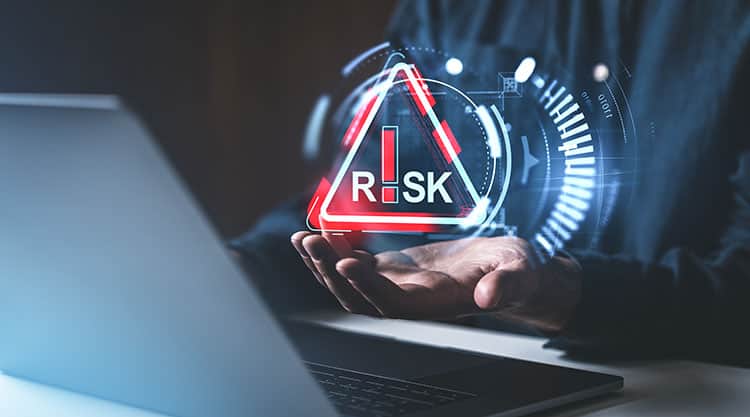-
How to Prepare Your Company for the Risks and Challenges of GenAI
As tech companies continue to invest in Artificial Intelligence (AI), the world scrambles to keep up with its rapid adoption for public and private use. There are some amazing potential benefits to adopting AI in the business world. As with any new technology, though, there are also risks and challenges.
Generative AI (GenAI) poses both internal and external risks. There are risks to consider when adopting AI in your company, and there are also risks that external threats could exploit to use GenAI to damage your company. Learning about these risks and taking steps to mitigate them can help ensure that AI is a boon to your company rather than a hindrance.

What Is GenAI?
The term “generative AI” refers to several different types of AI programs that create content. They’re designed to generate images, text, code, and other responses to a user’s prompt.
Large language models (LLMs) are one of the most familiar types of GenAI. These neural networks are trained on large amounts of text data so they can generate text in response to a prompt. Chat GPT and Google Gemini are examples of LLMs.
Diffusion models are another type of GenAI. These models also start with a text prompt, which they use to refine a starting image by removing “noise” until it matches the prompt. You can use them to create AI-generated images and videos.
Referencing a survey published near the end of 2024, two years after ChatGPT became available, CFO.com reported that only 9% of finance leaders currently used AI tools. The number is fast growing, though, with a new 2025 survey showing that 89% of surveyed executives describe their GenAI initiatives as “advancing.” Concerns about AI often slow down adoption, but it is steadily making its way into the business world.
Internal Challenges with GenAI
The Hackett Group’s 2025 survey, reported by CFO.com, included the top challenges that business executives report with implementing AI in their companies. Many of the top concerns revolve around a lack of understanding of AI within the company, including a lack of AI experience and unrealistic expectations for AI. AI is a new technology, and employees and executives will require education on how to use it and what to expect.
The top 10 “major concerns” reported in this survey also included “Intellectual property leakage concerns,” “Data privacy and regulatory concerns,” and “Data quality concerns.” Similarly, the 2024 Deloitte and IMA survey included “security concerns” and “data governance” among the top 5 challenges to implementing GenAI. The potential for security risks is among the most concerning downsides to using generative AI technology.
Using GenAI often involves giving those tools access to privileged information. Trade secrets, intellectual property, confidential data, and personally identifiable information can be at risk once they’re added to a large language model. An AI tool that isn’t properly trained and secured may leak information to unauthorized users. Even if your company’s security is good, third-party software might give hackers a way into the system. And on top of that, AI can “hallucinate,” or generate false information. If those hallucinations are used to make business decisions, there can be costly consequences.

External Risks from GenAI
There is also a risk that bad actors outside your company could use generative AI in an effort to target your company. Examples of how GenAI could be used to harm a company include AI-generated deepfake videos of executives, fraudulent press releases, and documents used to commit fraud.
A recent report from Deloitte’s Center for Financial Services “predicts that GenAI could drive a substantial increase in fraud losses in the United States: from some $12 billion in 2023 to $40 billion by 2027.” Fraudsters now have access to free and low-cost AI technology that enables sophisticated forgeries of everything from identity documents to invoices to watermarks to signatures. It’s frighteningly easy for criminals to forge documents that can slip past traditional fraud detection methods.
Fraudsters could also use AI to mimic specific people’s writing styles in emails. They might impersonate suppliers, generate fake approvals for fraudulent invoices, or hide malicious links in seemingly trustworthy communications. There are also concerns about the potential for using AI to generate malicious code to hack systems, such as your company’s financial processing software.
Fighting Fraud with BPA Technology
We’re not saying that all AI technology is bad. Even the type of AI that we’re discussing in this article, GenAI, can be used to enhance people’s lives and jobs. There are also other types of AI that are widely used in business, such as machine learning. Machine learning AI examines data and looks for patterns to improve the way the software performs tasks. It’s the basis for predictive AI, which looks at data to identify patterns and project possible outcomes.
Machine learning and predictive AI are used in a wide range of industries. A Business Process Automation (BPA) company can include machine learning in its software to improve functionality and enable the software to “learn” how to best serve your company. NextProcess’s BPA software includes machine learning. As you use our software to streamline and improve financial processing tasks, our software analyzes the data, learns from patterns, and makes predictions. The longer you use this type of software, the more the software understands your financial processes and the more efficient it becomes at analysis, pattern recognition, and more.
BPA software enhanced with machine learning is one tool you can use to fight back against the risks posed by malicious use of GenAI. Risk assessment, training, and communication are important steps toward mitigating the risks. In addition, Deloitte recommends implementing multifactor identification to verify the identities of those accessing your systems, using multiple levels of approval and rigorous document verification to catch sophisticated fraud, and collaborating across departments to continually update fraud-detection policies. BPA software can help with many of these tasks since you can customize the software to cross-verify documents, automatically enforce company policies, and verify users. Contact NextProcess today to learn more about how our secure, reliable platform can help your company prepare for new advances in technology.